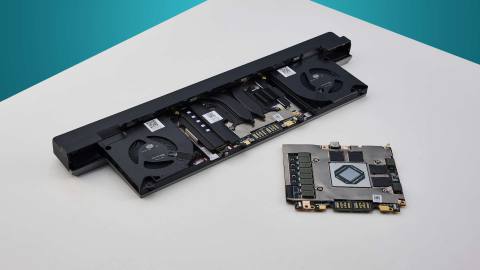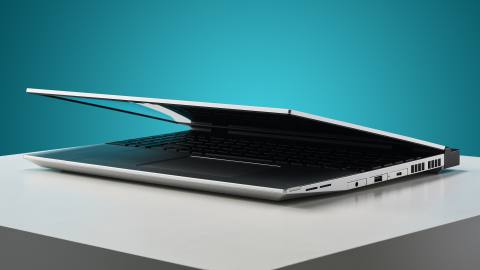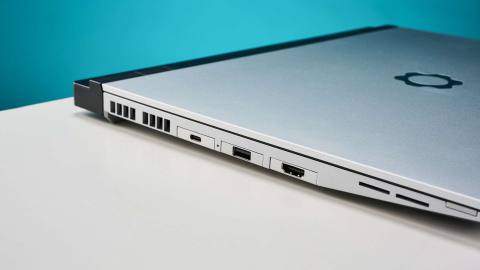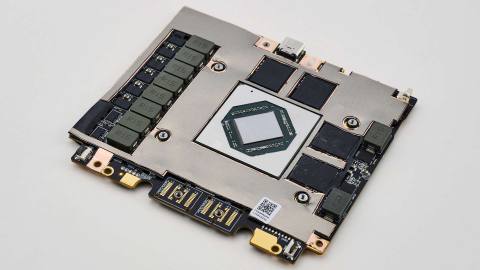The Framework 16 is the gaming laptop I've always wanted. Well… almost. If you put the Framework 16's GPU party piece into the Razer Blade 14 then you've got the gaming laptop I've always wanted, but this is certainly a vital step down that path. And without Framework there's no chance of ever getting there; it's also honestly pretty incredible this innovative machine works so well even in this first generation.
Because this here is a new breed of notebooks. One that ought to pave the way for genuinely upgradeable gaming laptops, in almost the same way we have endlessly configurable desktop PCs we can tweak to our heart's content. For all the promise of MXM modules, this is the first gaming laptop that a user can remove and replace the graphics card in only six twists of a Framework-supplied screwdriver.
As alluded to at the start, this machine's party piece is the ability to remove the graphics card as easily as you can a desktop PC's add-in board. It's all housed in a removable module which slots into the rear of the Framework 16, and can also be replaced with a blank housing if you just want to run on the machine's processor graphics to save on space and battery life.
The promise here is that, much like with Framework's existing mainboard offerings, you'll eventually be able to buy a next-generation module which adds a new, more powerful generation of graphics silicon to your machine. You will no longer have to buy an entirely new gaming laptop if you want to use a new line of mobile graphics… at least, that is the promise.
How that holds up over time is going to be down to support from both Framework and AMD, because it's this partnership between the two companies that has been intrinsic in getting this whole project off the ground. Which does mean that you are restricted to mobile AMD GPUs, and right now to only one SKU—the RX 7700S.
Framework 16: The quick verdict

The Framework 16 is an outstanding achievement and the upgradeable GPU isn't the only thing I'm talking about here either. This is the gaming laptop every nerdy PC gamer ought to covet. It can be a DIY build project, a starting point for an upgrade journey, and a notebook capable of engendering the same level of affection you might feel for a full desktop you've lovingly evolved over the years.
There's a quirky juxtaposition of impressive engineering and endearing jank to the Framework 16, and honestly only in a good way. That mix is the only way you're ever going to get a machine with this level of customisation on offer, even if it does mean a slightly wayward finish on the metal spacers.
The way you can reconfigure the machine on the fly, depending on what you're doing or where you might be going, is a supreme strength of the device. But the tantalising potential of being able to drop a whole new generation of mobile graphics chip into this exact machine a few years down the line, for markedly less than it would cost to buy a whole new gaming laptop is what would have me lining up to buy one.
But you are still going to have to square something with yourself first. The Framework 16 is not a cheap gaming laptop; it's supreme modularity costs, and its DIY nature isn't a recipe for being able to save yourself a few dollars here and there. You will be able to buy much faster gaming laptops for the same money, and we cannot here and now guarantee that there will be new generations of graphics cards released for this laptop.
Still, I'm impressed the RX 7700S works in the first place. The switch between integrated and discrete is pretty seamless, with neither Windows or the AMD drivers batting an eyelid when you change modules. And the RTX 4060-beating performance isn't too bad either… just not for the money.
But you're paying not for performance today, you're paying for its potential. And if you can't afford to do that right now, then it's maybe not the laptop for you. But if you're happy to suck up the mid-range gaming performance at this price, and willing to take a punt on the promise of a cheaper upgrade path down the line, well, this is the only real option.
And I think it's a great option at that.
Framework 16: The in-depth review

This is not the first time an GPU-upgradeable gaming laptop has been posited. The idea of a modular gaming laptop isn't new, and is something that's been teased by successive generations of mobile GPUs in MXM form. That was a mobile GPU socket standard originally designed to allow successive generations of graphics card to be dropped into laptops, but one that has evolved away from that to a point where the standard is only open to manufacturers wanting to drop new generations of graphics silicon into their last-gen platforms and is well beyond the end user simply craving an upgrade for their ageing laptop.
The notion of user upgradeable mobile graphics cards was also specifically promised by Alienware for its own Area-51m gaming laptop—though it's worth noting Dell only ever stated that it would definitely be offered for the GPUs on offer at launch and not necessarily future generations of laptop graphics. The fact it never managed a second generation of compatible GPUs for its much-vaunted gaming laptop with “unprecedented upgradeability” was the subject of an unsuccessful class action lawsuit a couple of years ago, though reportedly some owners received settlements for individual cases.
Suffice to say, the history of the upgradeable laptop GPU has not been a shining one.
Framework, though, has made it its mission to create a business on the back of the idea of offering complete upgradeability with its own laptops, and its Framework 13 machine has certainly delivered on that for non-gaming notebooks. It's so far three generations into Intel mainboards and has now started offering AMD motherboards, too, all able to be dropped into the same machine you might have bought three years ago.
But this is Framework's first stab at a proper gaming laptop with a discrete graphics card and a modular, user-upgradeable one at that. And its eventual success as a concept is probably not going to be apparent until we get to a point where you can buy a new RX 8700S or RX 8900 XT module to drop into your year-old Framework 16 and marvel at its suddenly supreme gaming frame rates.

And that reliance on future potential does make reviewing the first generation Framework 16 a mildly tricksome business.
So, why don't we just have a wee chat about the hardware on offer right now, rather than get too bogged down in talk of potential we cannot really pass full judgement on? As the name suggests—and as Framework passim would dictate—this is a 16-inch gaming laptop and very much fits in with the mould of the smaller Framework 13 I love so well.
It sports the same brushed aluminium finish, with the now-familiar cog logo adorning the lid, and it lines up with the same modular inputs on either side of the chassis, except with this larger frame you get space for two more. These are identical to Framework's other input modules, offering you almost complete choice as to how to configure your machine. Want to fill all six slots with USB Type-C ports? Go for it. Need a couple of HDMI and maybe a DisplayPort and ethernet connection to boot? No problem. Want to mix and match depending on whether you're at home or on the move? They're as easy to switch as swapping out a USB stick.

I’m absolutely a proponent of left-side numpads, and will not hear a word to the contrary, and this is the first laptop to ever give me that option.
It's a refreshing approach Framework has created, but the 16-inch goes further than the original 13-incher in every respect. One of the things I love the most about the modularity of the Framework 16 is the configurability of the keyboard. I'm fine with a mono-colour LED backlight, so the extra RGB options aren't a huge sell for me, but the option to have a numpad as and when you want it absolutely is.
I don't use a numpad all the time, but I love the Mountain Everest 60 on my desktop setup for the optional hotswappable numpad, and the Framework offers almost the exact same thing. It's not quite hotswappable, but once your laptop's powered off it takes moments to completely alter your keyboard layout as it's all just attached with strong magnets and a latch mechanism.
So, if you just want the standard keyboard on its own, that's fine, but shift it over to one side and there's space for a good sized numpad to drop in. And better still, you can have it on either side. I'm absolutely a proponent of left-side numpads, and will not hear a word to the contrary, and this is the first laptop to ever give me that option.
Though it does necessitate aligning the trackpad to the right hand side, however, and that I'm maybe not 100% keen on.
There's also an optional RGB macro-pad to fill that numpad space, too, which is a 24-key clear keycap pad that you can configure how you like through Framework's configuration tools. The configuration tools, for both the keyboard and the optional LED matrix spacers—yeah, you can properly glow up your machine—are largely online, which makes it all very accessible whether you've gone for the straight Windows prebuild or the DIY option and Linux.

I love endlessly tweaking and adjusting and just messing with the Framework 16.
This issue with all this modularity, however, is in the final finish of the device. Where we've become used to our laptop chassis hewn from single pieces of aluminium, the use of spacers either side of the trackpad module to allow it to move to either side means there's a necessary break in the finish. And it doesn't look great, most especially if you're offsetting the trackpad for a left-sided numpad where you end up with two of the thin aluminium spacers side-by-side.
Part of the issue is that there's a small, but noticeable difference in the finish of the aluminium on the spacer and that of the trackpad module, inevitably because they come from different pieces of metal. It's kind of unavoidable in this situation, but along with the non-uniform colouring there's also variability in just how well they fit together as they do not fit completely flush.
Again, it's a somewhat inevitable consequence of the ultra modular design, and while the finish isn't totally MacBook-perfect, it's still a compromise I am absolutely okay with in exchange for all the ease and utility which comes with Framework's customisable approach.
It also adds a certain endearingly janky quality to the device. And that probably sounds like a negative, but it all brings a warm glow to the 16-year-old boy sat at his parent's dining room table—with all the parts for a Cyrix 486 clone PC build strewn in front of him—that still resides inside me. I love a DIY project, I love desktop gaming PCs for their total customisability, and I love endlessly tweaking and adjusting and just messing with the Framework 16.




The 13-inch laptop gave me a taste of it, but this is the first gaming laptop that's ever made me feel the same sort of attachment and affection for it that my homebrew desktop gaming PC does. And, more importantly, it feels like just the starting point because I am supremely confident that this is a machine that is only going to get better, housing faster graphics chips, quicker, more powerful CPUs, and even slicker displays, too.
Because, like its other machines you can replace the entire 16-inch IPS, 165Hz display, and I don't doubt there will be other panels released over the years you will be able to swap in and out should you wish. Right now there is only this 2560 x 1600 panel, but it's super bright (with a 500cd/m2 typical luminance) and it's impressively responsive, too. I'm a little sad there's only an anti-glare matte finish option available, as I've only ever wanted the higher contrast the Framework 13's original glossy panel affords, but I guess there's a chance down the line.
So, when I'm talking about that air of ever so slight jank, it's never about the actual tech on offer, or the impressive engineering and actual build quality of the thing. It feels reassuringly solid, and though everything is attached with magnets and the occasional captive screw when it's all together it never feels anything less than a complete, cohesive device.
That modular keyboard feels robust, with no bounce to the typing experience, and the fingerprint reader is the most responsive I've ever used on any device. And I'm into that screen, too—sure, it's not a glorious mini-LED or OLED screen, but it's bright and colourful and delivers a crisp 16:10 image.
I'm also into the new AMD mainboards that come in the Framework 16, and while the storage option in my review spec is pretty miserly at 1TB, I love the fact there is a secondary M.2 slot directly underneath for a 2230 SSD, like you'll find in the Steam Deck. If you were running the SSD too hard you could make a case for the two being on top of each other being an issue, but there seems to be clearance enough that for most usage cases it won't be an issue.



The Ryzen 7 7840HS version would be my advice, because there are price premiums elsewhere, too.
You can get an AMD Ryzen 7 7840HS or Ryzen 9 7940HS, though while this Overkill spec machine I'm testing comes with that top part, there is precious little between them apart from a $200 premium. They're both eight-core, 16-thread Zen 4 chips, but the Ryzen 9 has a slight 100MHz clock speed bump on both the GPU and CPU boost clocks. Yes, you're right, it's not worth it—only look for the Ryzen 7 7840HS version would be my advice, because there are price premiums elsewhere, too.
But, nowhere is that impressive engineering more obvious than with that removable graphics card. The actual GPU module itself is compact and sits within a rear-mounting expansion bay which also houses the laptop's twin-fan cooling solution. Which is smart, because it makes the machine's cooling completely upgradeable in the future, too.
The way the graphics module connects is also very smart; it feels solid and like it will happily withstand repeated insertion. Which is what you want. It's not socketed to the motherboard like a desktop graphics card, instead it slides into the rear of the machine, clicks into place and you tighten two screws to secure the bay in place. Then you have a single interposer which screws into both the GPU and the mainboard, offering an accurate and confident connection.
There's nothing grinding against each other, and nothing that feels like it's going to really suffer from excess wear and tear unless you're really clumsy with the wee Framework torx screwdriver that comes with the laptop. Which, incidentally is all the tool you need to carry out any upgrade or teardown on your machine.
Framework 16: The benchmarks
What's less pleasing is the fact there is only a single GPU on offer: the Navi 33-powered AMD RX 7700S. If it was the same chip as the desktop RX 7700 XT I'd be much happier, but this is a mobile GPU that is essentially the RX 7600 of desktop infamy. Though if you take the heavily ray traced Cyberpunk 2077 you are getting gaming performance that tops the mobile RTX 4060 even in its 75W form.
And that's not bad, but when the cheapest Framework 16 that comes with the GPU expansion bay is still over $2,100 you can start to see where you're paying a premium for the engineering feat and the potential for never having to buy another gaming laptop in your life.

Do I believe in AMD, in it not getting distracted by something else and forgetting to keep supporting Framework’s efforts?
It's this price premium which is likely to be a sticking point for many gamers enticed by the promise of future upgradeability in their next gaming laptop. They're going to be put off by the fact they can get a notebook, which admittedly has none of the customisation or upgrade options, but will come with either an RTX 4070 or even RTX 4080 for the same sort of money.
It all comes back to my point at the very top of this review, you're not paying the money for its gaming performance right now, you're paying for the potential of not having to pay the same again in a few years when this RX 7700S GPU (or even your mate's RTX 4070 laptop) is starting to look a little leggy in terms of gaming performance.
If you could pay $500 for a high-performance gaming laptop upgrade, when everyone else is having to pay $2,000 for the same level of frame rates, who's the winner? If you're into playing the long game, and want to support a company doing something that is genuinely supporting the end user, then the Framework 16 is the only gaming laptop you should be considering.
Though I know that's a lot to ask when you're looking at the raw performance per dollar comparisons right now. And when that potential high-performance gaming laptop upgrade is still just that, potential.
But I believe in Framework. It's made it all work in the standard laptop space, where it's delivered generation upon generation of new laptop mainboards all able to fit in the same laptop chassis, and from different manufacturers, too. Though do I believe in AMD, in it not getting distracted by something else and forgetting to keep supporting Framework's efforts? After all, it doesn't have a great recent record in laptop graphics cards, does it?
I've got to hope Framework keeps AMD honest, and hope that this machine is enough of a success that AMD just has to keep expanding its support. And maybe, just maybe it will be able to entice Nvidia into giving it a go, too. Then we might see this nascent ultimately upgradeable laptop copied by every manufacturer worth a damn, and that's only going to be good for us all.






